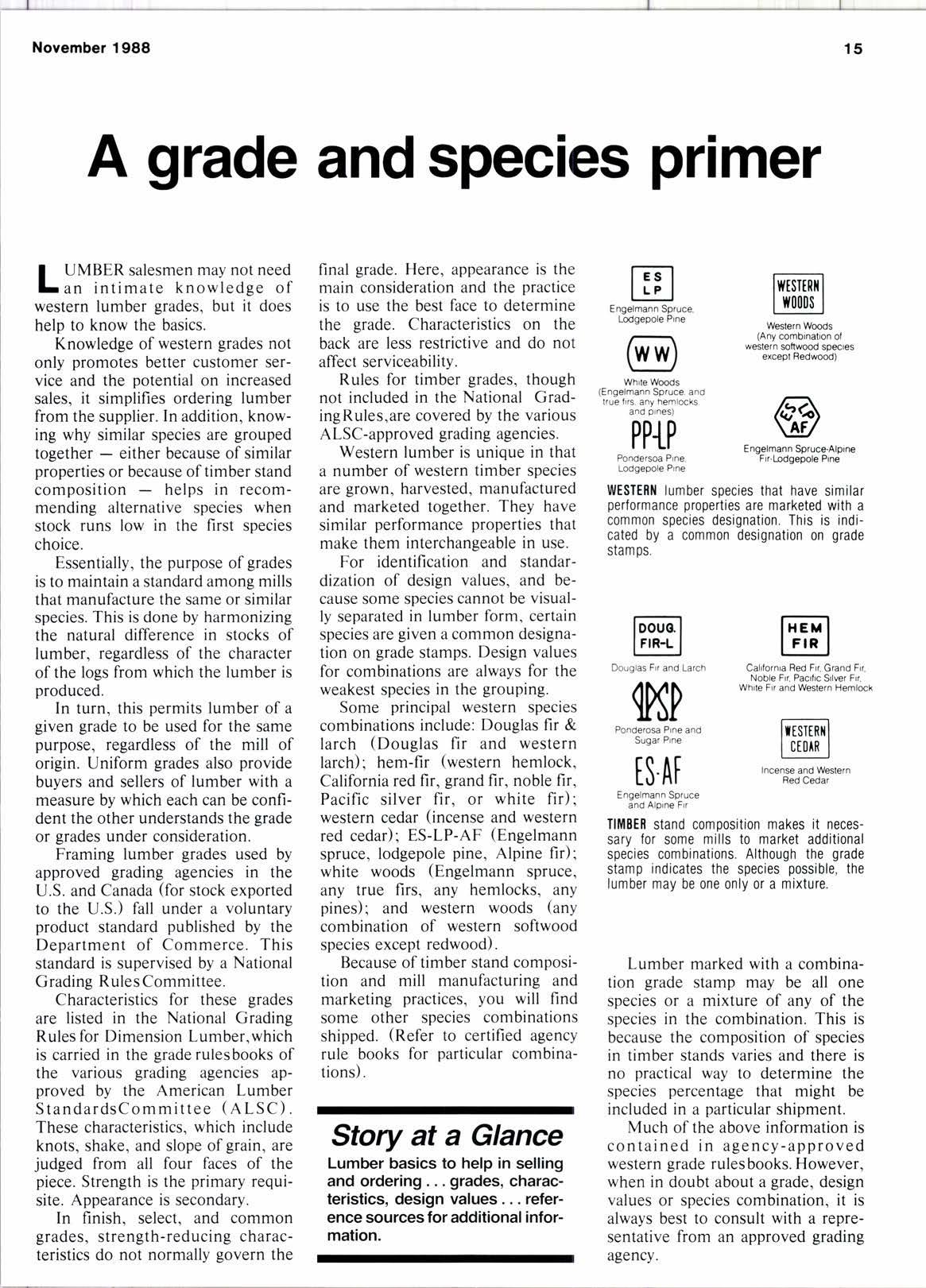
2 minute read
A grade and species primer
LUMBER salesmen may not need
Ian intimate knowledge of western lumber grades, but it does help to know the basics.
Knowledge of western grades not only promotes better customer service and the potential on increased sales, it simplifies ordering lumber from the supplier. In addition, knowing why similar species are grouped together - either because of similar properties or because of timber stand composition - helps in recommending alternative species when stock runs low in the first species choice.
Essentially, the purpose of grades is to maintain a standard among mills that manufacture the same or similar species. This is done by harmonizing the natural difference in stocks of lumber, regardless of the character of the logs from which the lumber is produced.
In turn, this permits lumber of a given grade to be used for the same purpose, regardless of the mill of origin. Uniform grades also provide buyers and sellers of lumber with a measure by which each can be confident the other understands the grade or grades under consideration.
Framing lumber grades used by approved grading agencies in the U.S. and Canada (for stock exported to the U.S.) fall under a voluntary product standard published by the Department of Commerce. This standard is supervised by a National Grading Rules Committee.
Characteristics for these grades are listed in the National Grading Rules for Dimension Lumber,which is carried in the grade rulesbooks of the various grading agencies approved by the American Lumber StandardsCommittee (ALSC). These characteristics, which include knots, shake, and slope ofgrain, are judged from all four faces of the piece. Strength is the primary requisite. Appearance is secondary.
In finish, select, and common grades, strength-reducing characteristics do not normally govern the final grade. Here, appearance is the main consideration and the practice is to use the best face to determine the grade. Characteristics on the back are less restrictive and do not affect serviceability.
Rules for timber grades, though not included in the National GradingRules,are covered by the various ALSC-approved grading agencies.
Western lumber is unique in that a number of western timber species are grown, harvested, manufactured and marketed together. They have similar performance properties that make them interchangeable in use.
For identification and standardization of design values, and because some species cannot be visually separated in lumber form, certain species are given a common designation on grade stamps. Design values for combinations are always for the weakest species in the grouping.
Some principal western species combinations include: Douglas fir & larch (Douglas fir and western larch) I hem-fir (western hemlock, California red fir, grand fir, noble fir, Pacific silver fir, or white flr) I western cedar (incense and western red cedar); ES-LP-AF (Engelmann spruce. lodgepole pine, Alpine fir): white woods (Engelmann spruce, any true firs, any hemlocks, any pines) I and western woods (any combination of western softwood species except redwood).
Because of timber stand composition and mill manufacturing and marketing practices, you will find some other species combinations shipped. (Refer to certified agency rule books for particular combinations).
Story at a Glance
Lumber basics to help in selling and ordering... grades, characteristics, design values. reference sources for additional information.
I Es I I LP I
Wl
PPTP
WESIERI{ lumber soecies that have similar performance properties are marketed with a common species designation. This is indicated by a common designation on grade sIam0s.
II'or
Is Af
TlilEEB stand comoosition makes it necessary lor some mills to market additional species combinations. Although the grade stamp indicates the species possible, the lumber may be one only or a mixture.
Lumber marked with a combination grade stamp may be all one species or a mixture of any of the species in the combination. This is because the composition of species in timber stands varies and there is no practical way to determine the species percentage that might be included in a particular shipment.
Much of the above information is contained in agency-approved western grade rulesbooks. However, when in doubt about a grade, design values or species combination, it is always best to consult with a representative from an approved grading agency.










